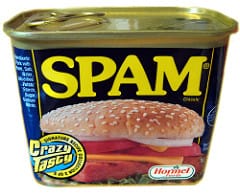This was another week with a fair amount of spam in my email inbox. We all receive email spam on a regular basis and most of us have probably also received science spam: invitations to scientific conferences about topics we are not working on, invitations to submit articles to journals not covering your field, and information about lab supplies we never had asked for. Although I’m of course aware that spam is now a fact of online life, I don’t quiet understand how this science spam works.
1. How do science spammers get my email address?
Most science spam is not really targeted toward my research interests. From this, I conclude that these spammers automatically harvest the email addresses of researchers, or they buy these lists. One potential source to harvest email addresses is PubMed and other bibliographic databases, but I don’t know whether this is actually done.
2. Is even a small percentage of researchers responding to this science spam?
Science spam is as uninteresting to me as any other spam, and I can’t really imagine a colleague submitting a manuscript to a journal marketed this way. But the idea behind spam is that there is a – admittedly very small – conversion rate.
3. When will we start to see more social media science spam?
I think it is only a question of time before we see more science spam on Twitter, Google+ and Facebook – I already receive a small amount of spam through these channels.
4. Is there anything an individual researcher can other than using good spam filters in his email program?
Would it for example help if we hide our email address as much as possible? Should we deny publishers the permission to post our email address in journal articles, and should places like PubMed hide them? Do publisher organizations such as OASPA (Open Access Scholarly Publishers Association) enforce their Member Code of Conduct, which clearly state that any direct marketing activities publishers engage in shall be appropriate and unobtrusive.
5. Will it get worse?
I know this answer. Yes. This blog has seen more than 60,000 spam comments already, most of the spam in my email is filtered out before I even see it, but I think it will get much worse – via email and other channels.


